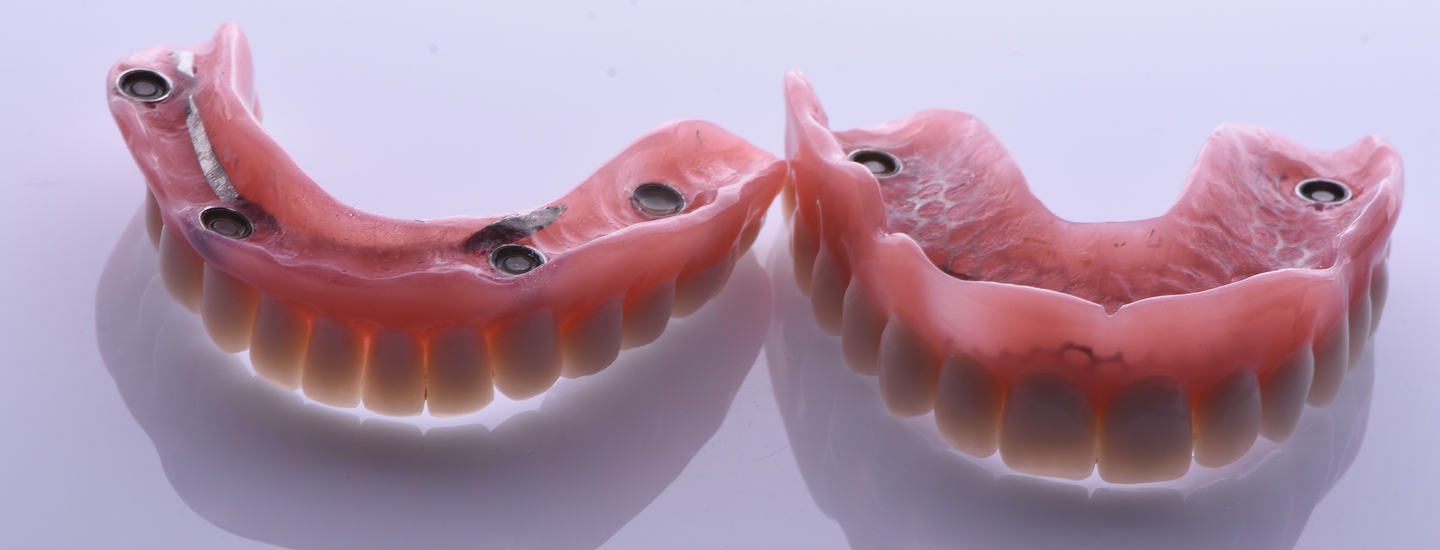
Dental denture that is fixed onto implants is called implant retained denture or clip-on denture, sometimes also called ball-retained denture. This type of restoration involves placing three or four implants per jaw and then later clipping a dental denture onto them.
PImplant retained denture is done a bit less today. It is favoured when there is not enough bone to use other implant solutions or the patient cannot yet afford a full implant restoration. Patients who are facing problems of edentulism or complete edentulism are more likely to choose All-on-4 or All-on-6, which involves placing a similar number of implants and the use of fixed ceramic crowns rather than mobile plastic dentures.
Implant retained denture is cheaper than All-on-4 restoration, but if you are going to undergo a placement procedure of 4 implants per jaw, most patients will rather go for fixed crowns, which provide superior comfort. This comfort is reflected in the temporary restoration as well, which a patient wears for months to let the implants integrate with bones. When you go for the implant retained denture, the temporary restoration is a common plastic denture, unlike the All-on-4, where you get a fixed temporary bridge.
A great advantage of a fixed restoration is also the appearance, since crowns look like perfectly healthy teeth, with some of the other benefits being natural speech, better food enjoyment, easier hygiene, and the fact that a fixed restoration does not move in your mouth, unlike the denture.
This type of denture is an excellent alternative to the plain plastic denture, which is used by most elderly people in our country. There will be no more gluing of the denture needed, it will be stable and chewing will be much easier. Therefore, we recommend implant retained denture as an excellent solution for toothlessness, especially for those who do not wish to invest large sums into an implant restoration with ceramic crowns.
Patients who have carried common dentures are generally very happy with implant retained ones. Once these patients transit from one to the other, they are especially delighted that there are no parts of the denture covering the palate which used to block the taste buds, and food may be enjoyed more thoroughly again. On the other hand, patients who call in having their natural teeth deteriorating and would like a permanent solution hardly are able to get used to this type of restoration, because what they are used to are their natural teeth, and therefore, these patients are advised to go straight for a full implant restoration.
The procedure of fabrication itself is relatively simple. The ideal number of dental implants to retain a plastic denture is four for each jaw, but sometimes three implants per jaw are used. The benefit of a four screw restoration is that the patient does not have to worry about possible complications, because if one titanium screw does not integrate with the jawbone, the whole implant-denture construction continues to be held firm by the three remaining implants.
The first stage involves placement of three or four dental implants, overstitching of dental screws and a period of recuperation of minimum three months for the bottom, and four months for the upper jaw in order for the titanium screws to integrate. Usually during this period a plain removable denture is used. This may be a denture already used by the patient, but remodeled and padded so as not to damage the surgical cut, or a new temporary denture may be used for patients who have not had one before.
After a few months, the dental implants are reopened and special studs are screwed onto them, while sockets are placed into the denture. Finally, the sockets are snapped onto the studs. At this phase, a new denture is always made which is trimmed towards the palate and along other axes, but is fortified by metal wiring so as not to snap due to the trimming. As soon as the denture is placed the patient should be able to speak and eat without any difficulties.
Until recently, this used to be true, but not anymore. Indeed, if after the CBCT analysis we determine that a patient does not have enough bone quantity and quality to place 6-8 dental implants, we advise going for the denture restoration. However, the advancements made in implant fabrication materials have enabled us to place implants in places which were deemed precarious before, and, more importantly, bone grafting techniques have also improved so that the jaws may be successfully prepared for a fixed dental restoration, albeit at a higher cost. Year after year, more and more patients decide to go for proper dental implants, despite the initial weak bones and the lack of bones.
